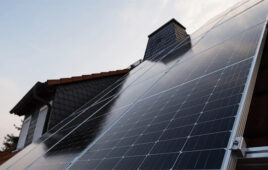When Congress passed last year’s Infrastructure Investment and Jobs Act (IIJA), also known as the Bipartisan Infrastructure Bill, the stage was set for a very different future in terms of how the United States viewed its responsibility to climate change. With historic investment in clean energy transmission, the first ever network of electric vehicle (EV) chargers and internet for every citizen, this $1.2 trillion bill unlocked a country-wide upgrade like no other.
 Get your complimentary copy of the full report here!
Get your complimentary copy of the full report here!
Addressing climate-related concerns head on, it includes improvements to roads and bridges, investment in public transport, the removal of all lead pipes, clean drinking water for all, the modernization of airports, ports and waterways — and more jobs. However, President Biden’s proposed $1.75 trillion social spending and climate mitigation Build Back Better (BBB) bill did not fare so well after it stalled in the U.S. Senate last November.
Negotiations are continuing, with the president remaining hopeful that it can become law, albeit with changes. “I’m confident we can get pieces, big chunks of the Build Back Better law signed into law,” said President Biden in January.
As debate continues about the impact of these hefty packages, this legislative push has put energy transition at the center of policy. With or without the Build Back Better bill, what has become clear is that there has been a sea change in terms of how government and industry approach issues of clean energy, net-zero emissions policies and decarbonization plans for the next 30 years and beyond.
With far-reaching ramifications, what will be the impact of these bills on businesses? And as the United States rebuilds and aims for net zero, this paper looks at what the bills mean, their ripple effect and how industry should strategize. These issues and more will be addressed at Reuters Events’ Energy Transition North America. The Houston-based conference will unite chief executives and changemakers from across the energy, industrial and government ecosystems to shed light on these defining issues.
With Federal Departments under the gun to implement the IIJA, it is now up to those at state and county level to start the wheels turning. This is set to unleash a much-needed spending spree. The American Society of Civil Engineers publishes an infrastructure report card every four years, and the last one, in 2021, rated the nation as a C-.
So, who gets what from the legislation so far? The White House has set out its numbers and states receiving top funding include California, Texas and New York. Each is getting more than $25 billion. However, the biggest impact, proportionately, will be in states such as Alaska (with $6,700 in funding per capita), Wyoming ($4,400) and Montana and Vermont ($3,500 each).
Jerome Zeringue, who chairs the Appropriations Committee, says the timeline for the allocation rests on many factors. “It all depends on where the project is, how advanced it is, and when the money is available,” he said last November. “But ideally, we can get some of these projects started within the next several months.”





Tell Us What You Think!